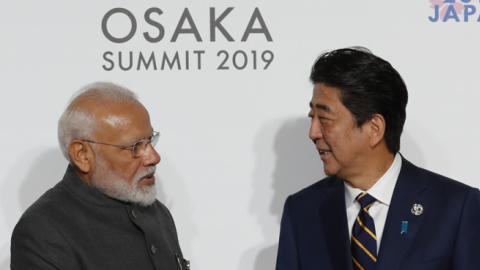The most notable aspect of the June 2019 G20 summit in Osaka, Japan, was the US-China summit. The United States and China agreed to a “ceasefire” in their “trade war” and to resume trade talks. However, because the two countries did not agree to end the trade war altogether, the confrontation in this domain continues. Meanwhile, the leaders of India, Japan, and the United States of America held a trilateral summit and promised to hold such a meeting every year.
In December 2017, when the United States published its new National Security Strategy, the stage was set for a confrontation with China. The document explicitly stated that “China and Russia challenge American power.” Shortly thereafter, in January 2018, the USA imposed tariff s on China, setting off the so-called trade war. The Chinese retaliated by imposing their own tariff s on the USA, and the trade war escalated. In October 2018, when Vice President, Mike Pence spoke at the Hudson Institute, he said: “Beijing is employing a whole-of-government approach, using political, economic, and military tools, as well as propaganda, to advance its influence and benefit its interests in the United States of America.” Therefore, he explained, citing the National Security Strategy, “the United States of America has adopted a new approach to China.” Furthermore, in June 2019 the US Department of Defence published its Indo-Pacifi c Strategy Report, which refers to China as a “revisionist power.”
USA-Chinese relations have remained tense since these developments, and countries such as India and Japan have had to adapt to the new circumstances. This raises several questions. In the long run, which side will win, and what are the implications for India and Japan? Why has the USA recently stepped up its actions vis-à-vis China? What should India and Japan expect from the USA’s new approach to China, and how should they respond? The United States of America is now the world’s only superpower, a status it acquired by defeating Germany and Japan in World War II and then the Soviet Union in the Cold War. If there is a lesson from this history, what is it? Because of its unfortunate and tragic history of war with the USA, Japan knows not to underestimate the seriousness of the United States of America’s strong stance on China.
After World War I, the USA developed plans for possible future war scenarios with various countries, including Germany and Japan (such as the “War Plan Orange” the “War Plan Black” or “Rainbow plans”). These plans were not precisely worked out but indicated a general strategic direction. When these plans were declassified in 1974, many were surprised to fi nd that the USA even had a war plan to confront the United Kingdom and Canada (the “War Plan Red”). From a realist perspective, these plans were justifiable, even if some of the potential “enemies” were in fact allies. American strategic thinking is indeed quite realistic, and thus the Japanese take seriously the explicit statements in the National Security Strategy and the Indo-Pacifi c Strategy Report. Japan understands that, there is a high possibility that, the USA currently has a plan for confronting China. Additional evidence suggests that recent USA actions are part of a long-term strategy. A good example is the so-called high-tech war between the USA and China. Beginning in 2018 and continuing this year, the USA has imposed sanctions against Chinese technology entities, blocking their ability to buy USA software and components. ZTE, for example, was
acutely affected by these sanctions. Although this is a policy of the Trump administration, the process behind the policy started several years ago under the Obama administration.
In 2012, the USA Congress was already addressing concerns over Huawei and ZTE, issuing an investigative report on the national security issues posed by these two Chinese telecommunication giants. Thus, recent events are part of a long-term strategy stemming from a view of China shared by Republicans and Democrats. Why has the USA recently toughened its policy toward China? First, China’s activities are directly challenging USA interests. But second, the USA recognizes that it might only be able to win if it steps up now. Some simple facts confirm that now is the best time for the USA to pressure China. For example, according to figures published by the UNESCO Institute for Statistics in July 2018, the United States of America invests USD 476 billion in research and development, compared with China’s USD 371 billion. This means that the USA still has a financial advantage in developing new technology. Similarly, the International Monetary Fund’s World Economic Outlook Database for January 2018 shows that the USA economy is larger than China’s, with USA GDP at USD 19.39 trillion, compared with China’s USD 12.24 trillion. The USA is also stronger militarily, with the USA defence budget at USD 603 billion, compared with China’s at USD 150 billion, according to the International Institute of Strategic Studies in London
Thus, given current technology and levels of investment in R&D, the USA is likely to win the high-tech war. Based on economic might, it is likely to win the trade war. And, based on military might, it is likely to deter or win a “hot” war. These likelihoods, in turn, mean that the USA will likely be able to increase pressure on China—first, technologically, second, economically, and finally, militarily—until China stops challenging USA interests.
How should India and Japan respond to USA-China tensions? In the long run, it will be beneficial to India and Japan to cooperate with the United States of America. Why? To put it simply, because the United States of America will win. There are three paths India and Japan should take: First: the two nations should increase investment in high-tech research. The high-tech war between the USA and China has shown that the USA is sensitive regarding protecting itself in the technology realm. India and Japan need their own technology cards to play, as both would benefit from a technological give and take with the USA. In this area, India and Japan can cooperate with each other. Joint development projects on artificial intelligence (AI) and AI-related unmanned ground vehicles (which could possible be used for patrolling the India-China border) are good examples.
Second: India and Japan can maintain cooperation with China for now but should not depend on China economically in the long run. India and Japan must reduce their economic dependence on China if they wish to avoid being damaged by the USA-China confrontation. For both India and Japan, China is the largest trading partner. The two countries should reduce the influence of China’s economy on their own. Japan has already begun to do so, ending its official development assistance to China in 2018. In addition, Japanese companies have relocated their factories from China to Southeast Asia or South Asia. As a result, the number of Japanese citizens living in China has decreased every year from 2012 to 2017.
Third, given the current USA demand to share the security burden presented by China, India and Japan should respond by increasing their own defence capabilities. Indeed, enhancing security in the Indian Ocean region is not only in the United States of America’s interest but also in India’s own interest. Thus, given that the Indian navy lacks anti-submarine capabilities, it would be beneficial for India to buy P-8 anti-submarine patrol planes and MH-60 anti-submarine helicopters. India can also increase its defence capabilities along its border with China by using USA-made equipment. India has imported USA-made C-17 heavy transport planes, C-130 transport planes, CH-47 heavy lift helicopters, M777 airlift ultralight howitzers, and AH-64 high-altitude attack helicopters to defend the border area. In the case of Japan, that nation is acquiring limited offensive capabilities by importing 100 F-35s stealth fighter jets from the USA.
Now is the time to work toward improved security cooperation among India, Japan, and the United States of America. In a time of USA-China confrontation, India and Japan should strive to transform this confrontation into an opportunity to promote even stronger relations with their American ally.

















